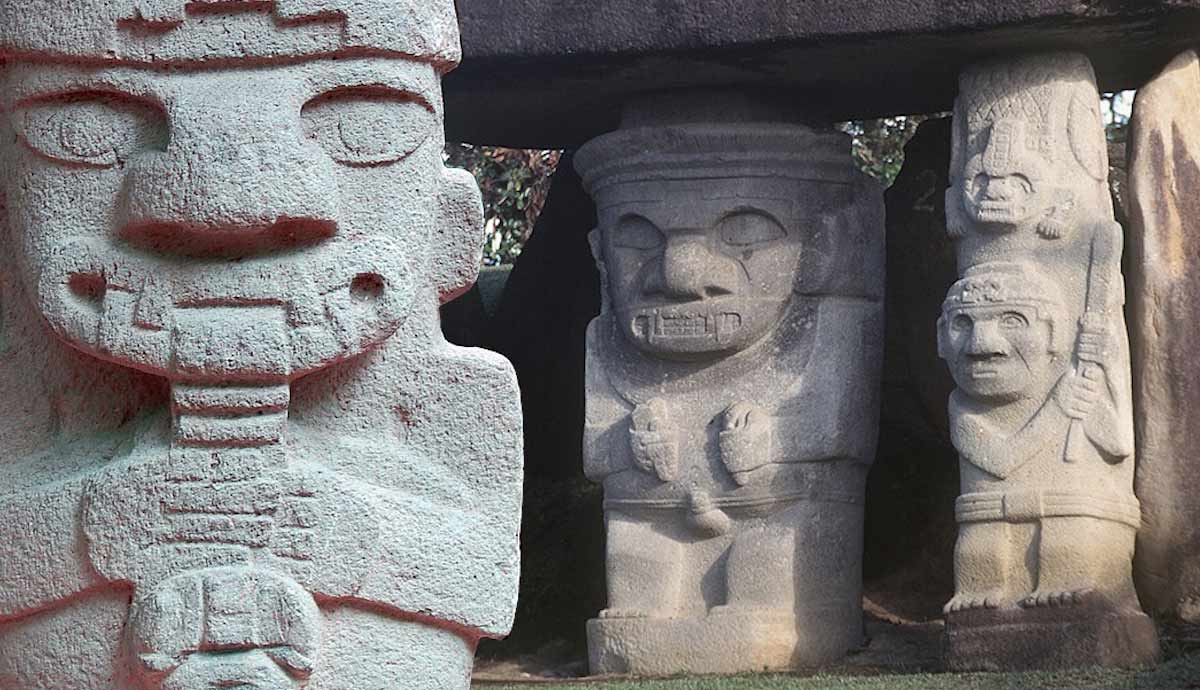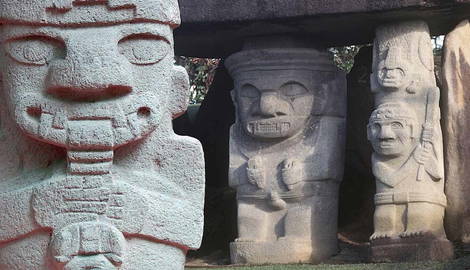
San Agustin is an archaeological park located in the region of Huila, southern Colombia. It is known as the major complex of megalithic sculptures of pre-Hispanic America. This archaeological park conserves the lithic remains of one of the most mysterious pre-Columbian cultures in the country, whose origins and reasons for disappearance are still unknown.
What Do We Know About This Culture?

The archaeological complex of San Agustín is considered the world’s biggest necropolis, whose temples and sculptures correspond to various communities that shared social structures and systems of beliefs. Their story has been unfolded by archaeological research that has studied the sculptures and temples found in these archaeological sites since the 18th century.
The culture of San Agustín settled on the macizo Colombiano, a mountain cluster that marks the end of the Andes Cordillera and splits into three smaller mountain ranges to the north, which shapes Colombia’s topography. The culture of San Agustín gets its name from the village of San Agustin, an urban settlement close to where the archaeological remains were found.

Evidence of the culture of San Austin has been found in over 300 archaeological sites in an area of 3,000 square meters (Duque, 2017). The lithic elements are spread over a geographical area bounded by the Chocoan rainforest to the west, the Andean Cordillera to the south, and the Amazonian rainforest to the east. Primary sites include Mesitas, where the oldest tombs were found, and La Estación, the most important architectural structure (Duque, 2017). Other important sites include the Alto de los Ídolos, the Alto de las Piedras, El Purutal and La Pelota, and La Chaquira, a big rock carved in-situ facing a valley and exhibiting three faces pointing towards different directions: a jaguar to the horizon, a face looking at the north and a female entity looking to the south (Palomo, 2023). The location of nearby rock deposits suggests that this community had sophisticated knowledge of techniques to move heavy loads of rock through uneven terrain.

What is peculiar about this culture is that it vanished from the historical record among local inhabitants. They knew about the monolithic rests but could not identify the makers and the purposes of such sculptures and temples (Duque, 2017). Ritual elements, residential units, mortuary temples, and tombs caught the attention of explorers in the times of the Conquest of the Americas in the 18th century. This led to pillaging from former explorers who were seeking treasures and wealth. However, even when the archaeological region was considered a site of national interest, robberies and looting did not stop.

In the 18th century, the first person who accounted San Agustin’s lithic industry was the Spanish Franciscan priest Juan de Santa Gertrudis, who arrived on the continent in 1755. This was the period when Spanish colonial power settled in what was known as the Viceroyalty of Nueva Granada. Juan de Santa Gertrudis published his “discoveries” in an essay called Maravillas de la Naturaleza (Marvels of Nature), where he described San Agustín. Later, Francisco José de Caldas in 1797 and Agustín Codazzi in the mid-19th century made considerable contributions to the illustration of the archaeological site and opened doors for archaeological interest from Colombian researchers in the 19th and 20th centuries (Palomo, 2023).
German archaeologist Konrad Theodor Preuss was the first scientist to research the archeological sites. He arrived in the Colombian city of Barranquilla in 1913 and traveled down the River Magdalena until he reached the region where the sculptures were covered by soil and vegetation. Fascinated by his discoveries, he illegally packed 21 statues and sent them to Europe, now retained by the Ethnological Museum in Berlin (Silva, 2016). There is an active campaign for repatriating these sculptures from the Ethnological Museum in Berlin in present times.
The constant uncontrolled looting of the archaeological pieces continued, making the state buy lands and properties and declare the zone an archaeological protected region in 1941 (Duque, 2017). Some decades later, the park was declared a national monument in 1993 and inscribed in UNESCO’s World Heritage list in 1995.
Where Did This Community Come From?

Colombian archaeological research proposes a timeline that sets this culture’s formation period from 1000 BCE to the 1st century CE (Duque, 2017). However, more recent research proposes earlier origins to even 3000 BCE (González, 2013). The period where it is believed all the monolithic monuments and lithic temples were built is called the Classical Regional Period and corresponds to the 1st century CE to 900 CE (Duque, 2017). It is believed that the culture of San Agustín gathered different social settlements that shared common social structures and beliefs with origins in the Amazon Jungle (González, 2013).
It is still unknown why, at the time of the Conquest of Colombia, the monuments were abandoned in the place where one of the main pre-Hispanic Colombian cultures inhabited. The lithic temples and residencies were believed to have been left behind around 1530, only a few decades after Christopher Columbus inaugurated the colonial era in the Americas. Because of the size of the monuments, which are lower in size than those of other more popularized pre-Hispanic cultures, such as the Inca (Tahuantisuyo), Maya-Mexica, or Aztec, the nature rapidly covered most of the rocks, hiding them from explorers and inhabitants’ gaze.
The lithic architecture and mythical representation

The houses are believed to have been built with wooden pillars stuck on a circular platform. The walls were made of bahareque, an ancient building technique found in many communities in the Americas that consisted of a mixture of mud and hay intercalated with wooden sticks. The roofs consisted of conical structures made of hay. The residential units sometimes were mixed with mortuary functions and have been found dispersed around the territory and not as urban clusters.
Local archaeology suggests that mortuary temples served as places for commemorating the death of relevant social people who were believed to have a special connection with spiritual forces (Jáuregui, 2022). This suggests that there was a hierarchized social structure linked to cosmological entities that were represented in the ceremonial sculptures.

Although the meaning of all lithic representations remains unknown, most of the lithic industry of San Agustin consisted of monumental representation and a characteristic symbolical style of naturalism and mythical zoomorphic and anthropomorphic. These entities were represented with detailed carved features and the use of color and pigments. Many statues represent life and death, the forces of nature, felines, reptiles, and mythical ancestry (Arango, 2010).

Some design motifs include a squared mouth with prominent fangs related to the myth of the Jaguar found in other Amazonian indigenous communities that inhabit the region nowadays. The representation of the duality of eagle-snake and other animals also repeats and has been found among other pre-Hispanic civilizations (Arango, 2010).
Other details include small facial details such as soft smiles and head and wrist accessories. Most of the statues show the articulation of animal forms and a basic human figure, which shows a different way of thinking from Western civilization. Instead of conceiving nature from the perspective of culture, these images represent a zoomorphic vision of nature or culture conceived from the perception of nature (Velandia, 1999).
One of the most beautiful sites is the fountain of Lavapatas, a series of channels carved in the stone where a small river runs down the hill. In this place, carved figures have been found, and the site is believed to be used for ritual and ceremonial purification rites (Duque, 2017). The architectural constructions have also revealed the community’s deep knowledge of astronomy, yearly cycles, and astral alignments.
The Current State of the San Agustín

The archaeological site of San Agustín opened research paths for the development of Colombian archaeology as a formal discipline. It has posited the relevant question about the still unknown origins of pre-Hispanic cultures, whose routes of migration and adaptative processes are still subject to research. As with many other archaeological sites that foreign explorers discovered, San Agustin joins the list of archaeological sites whose material culture is retained in places where they do not belong.
Nowadays, San Agustin is one of the main tourist attractions in Colombia for those interested in history and culture. The national interest that generated the remains in the 20th century and the inscription of the park as a World’s Cultural Heritage in the 90s have created a space for reflection on the origins of Colombian communities and the preservation of the stones and temples that rise in an extensive terrain dedicated only to archaeological research and cultural promotion.
Bibliography
Arango, T. (2010). Cultura Megalítica de San Agustín. Universidad Distrital Francisco José de Caldas. Museo del Oro del Banco de la República. Retrieved from https://www.todacolombia.com/culturas-precolombinas-en-colombia/cultura-san-agustin-3.html.
Duque, J. P. (2017). San Agustín. Retrieved from https://www.banrepcultural.org/biblioteca-virtual/credencial-historia/numero-335/san-agustin.
González, V. (2013). ¿Qué sabemos de San Agustín?. Boletín de Historia y Antigüedades – Enero.
Jáuregui, D. (2022). ¿Qué tan antiguas son las estatuas de San Agustín?. Retrieved from https://www.senalcolombia.tv/cultura/restos-arqueologicos-san-agustin-antiguedad.
Palomo, A. (2023). San Agustín, una visita a la misteriosa “biblioteca en piedra” más importante de América Latina. Retrieved from https://elpais.com/elviajero/2023-06-14/san-agustin-una-visita-a-la-misteriosa-biblioteca-en-piedra-mas-importante-de-america-latina.html.
Silva, V. (2016). Preuss, el alemán que descubrió San Agustín y se robó 21 estatuas. Las 2 Orillas. Retrieved from https://www.las2orillas.co/el-aleman-que-descubrio-san-agustin-y-se-robo-21-estatuas/.
Velandia, C. (1999). The archaeological culture of San Agustín. Towards a new interpretation. In Archeology in Latin America. Routledge, London.










